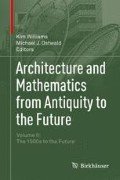Abstract
The development of computational algorithms for the transformation of geometry made the process of producing curvilinear forms deceptively simple. However, historically the production of intricate architectural forms was undertaken by designers who were aware of the cultural or symbolic connotations of such forms. For example, the construction of the archetypal Baroque compound curve was a clear response to the social, symbolic and phenomenological needs of the era. Thus, the construction of these curves could be said to have an ethical function in terms of their support for a dominant set of social values. The present paper analyses a series of examples wherein computer generated curvilinear geometric forms have been produced, to interrogate the extent to which such techniques could be seen as being ethically sound. Through this analysis the paper argues that geometry in architecture is more than simply a formal tool, but rather it is a device which has wider significance and more important properties and potentialities.
First published as: Michael J. Ostwald , “Ethics and Geometry: Computational Transformations and the Curved Surface in Architecture”, pp. 77–92 in Nexus VI: Architecture and Mathematics, Sylvie Duvernoy and Orietta Pedemonte, eds. Turin: Kim Williams Books, 2006.
Access this chapter
Tax calculation will be finalised at checkout
Purchases are for personal use only
Notes
- 1.
A problem with virtue theory, and its architectural application, is that it is asynchronous with many contemporary values. Virtue theory tends to be derived from traditional or normative western thought. Virtue theory should not be dismissed for this reason alone but it does have more in common with historic approaches to architecture than contemporary computational ones.
- 2.
A counter argument would be that, historically the social contract was never as widely accepted as architectural scholars would like to believe.
References
Beauchamp, Tom L. 2001. Philosophical Ethics: an Introduction to Moral Philosophy. Boston: McGraw-Hill.
Broadbent, Geoffrey. 1970. Meaning into Architecture. Pp. 50-75 in C. Jencks and G. Baird, eds. Meaning in Architecture. New York: George Braziller.
Cook, E. T. and Wedderburn, A. eds. 1903-12. The Works of John Ruskin (Library Edition, 39 vols.). London: George Allen.
De Saussure, Ferdinand. 1959. Course in General Linguistics. London: Peter Owen Limited.
Derrida, Jacques. 1989. An Introduction to Edmund Husserl’s Origin of Geometry. Lincoln: University of Nebraska Press.
Devereaux, Mary. 2001. Beauty and Evil: The Case of Leni Riefenstahl’s Triumph of the Will. Pp 227-256 in J. Levinson, ed. Aesthetics and Ethics: Essays at the Intersection. Cambridge: Cambridge University Press.
Dovey, Kim. 1999. Framing Places: Mediating Power in Built Form. London: Routledge.
Eco, Umberto. 1980. Function and Sign: The Semiotics of Architecture. Pp. 56-65 in G. Broadbent and C. Jencks, eds. Signs, Symbols and Architecture. New York: Wiley.
Elden, Stuart. 2001. The Place of Geometry: Heidegger’s Mathematical Excursus on Aristotle. The Heythrop Journal 42, 1: 311-328.
Evans, Robin. 1995. The Projective Cast: Architecture and its Three Geometries. Cambridge, Mass.: MIT Press.
Gaut, Berys. 2001. The Ethical Criticism of Art. Pp 182-203 in J. Levinson, ed. Aesthetics and Ethics: Essays at the Intersection. Cambridge: Cambridge University Press.
Grant, Hardy. 1990. Geometry and Politics: Mathematics in the Thought of Thomas Hobbes. Mathematics Magazine 63, 3: 147-154.
Harries, Karsten. 1997. The Ethical Function of Architecture. Cambridge: MIT Press.
Kolatin, Solan and Macdonald, Bill. 2000. Excursus Chimera? Architectural Design 70, 3: 71-77.
———. 2001. Chimerical Housings: Mass Customised Housing. Pp. 24-29 in M. Burry, ed. Cyberspace, The World of Digital Architecture. Melbourne: Images Publishing.
Kruft, Hanno W. 1994. A History of Architectural Theory from Vitruvius to the Present. New York: Princeton Architectural Press.
Lachterman, David R. 1989. The Ethics of Geometry: A Genealogy of Modernity. New York: Routledge.
Levine, Michale P., Miller, Kristine and Taylor, William. 2004. Ethics and Architecture. The Philosophical Forum 35, 2: 103-115.
Lynn, Greg. 1995. Blobs. Journal of Philosophy and the Visual Arts 6: 39-44.
———, ed. 1999. Animate Form. New York: Princeton Architectural Press.
Meek, Harold A. 1988. Guarino Guarini and His Architecture. New Haven: Yale University Press.
Mitchell, William J. 1990. The Logic of Architecture: Design Computation and Cognition. Cambridge, Mass.: MIT Press.
Moore, R. John and Ostwald, Michael J. 1997. Colubrine Chains and Right Lines: A Dædalic Analysis of Ruskin’s ‘Living Waves’.” Pp. 436-439 in Architecture: Material and Imagined. Washington DC: Association of Collegiate Schools of Architecture.
Norberg-Schulz, Christian. 1971. Baroque Architecture. New York: Harry N. Abrams.
———. 1980. Late Baroque and Rococo Architecture. Milan: Electra.
Pérez-Gómez, Alberto. 1992. Architecture and the Crisis of Modern Science. Cambridge, Mass.: MIT Press.
Pérez-Gómez, Alberto and Pelletier, Louise. 1997. Architectural Representation and the Perspective Hinge. Cambridge, Mass.: MIT Press.
Rykwert, Joseph. 1987. The First Moderns: The Architects of the Eighteenth Century. Cambridge, Mass.: MIT Press.
Sacksteder, Williams. 1980. Hobbes: The Art of the Geometricians. Journal of the History of Philosophy 18: 131-146.
Spector, Tom. 2001. The Ethical Architect: The Dilemma of Contemporary Practice. New York: Princeton Architectural Press.
Taylor, Nigel. 2000. Ethical Arguments about the Aesthetics of Architecture. Pp 193-206 in W. Fox, ed. Ethics and the Built Environment. London: Routledge.
Thompson, D’Arcy W. 1961. On Growth and Form (1942) London: Cambridge University Press.
Wasserman, Barry, Sullivan, Patrick and Palermo, Gregory. 2000. Ethics and the Practice of Architecture. New York: John Wiley & Sons Ltd.
Author information
Authors and Affiliations
Corresponding author
Editor information
Editors and Affiliations
Rights and permissions
Copyright information
© 2015 Springer International Publishing Switzerland
About this chapter
Cite this chapter
Ostwald, M.J. (2015). Ethics and Geometry: Computational Transformations and the Curved Surface in Architecture. In: Williams, K., Ostwald, M. (eds) Architecture and Mathematics from Antiquity to the Future. Birkhäuser, Cham. https://doi.org/10.1007/978-3-319-00143-2_43
Download citation
DOI: https://doi.org/10.1007/978-3-319-00143-2_43
Published:
Publisher Name: Birkhäuser, Cham
Print ISBN: 978-3-319-00142-5
Online ISBN: 978-3-319-00143-2
eBook Packages: Mathematics and StatisticsMathematics and Statistics (R0)

